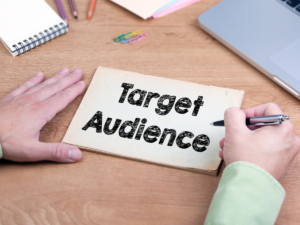September 23, 2024
5 Advanced Email Marketing…
Is your business looking to implement some new B2B email...

To determine if you can have more than one target audience you first need to understand:
Whether you’re a seasoned marketer or just starting out, mastering the art of audience targeting can significantly elevate your marketing efforts and drive tangible results.
So, let’s look into what a target audience is, whether you can have more than one target audience and how you can define them.
Your target audience is a specific group of people that you want to sell your products and services to. When thinking about your target audience, it is important to consider who will benefit most from what you are offering. Having a clear understanding of who your target audience is plays a huge part in the success of any marketing campaign.
People within your target audience will often have similar interests, behaviours and demographics. You can define your target audience based on various traits including:

Put simply, yes. Some businesses will have products or services that appeal to more than one target audience. But it is crucial that you look at each audience separately and acknowledge how they are different. The whole point in defining your audience is so that you can produce tailored content for them.
You need to be prepared to create different content for different audiences. This can be time consuming but having relevant content for each audience will help you establish deeper connections and increase engagement.
The biggest mistake you can make is taking a one size fits all approach to your marketing. For example, a small start-up seeking cost-effective solutions will have different priorities to large corporations demanding high-capacity systems tailored to intricate production lines. Attempting to apply a singular strategy disregards the business’ different requirements, ultimately limiting the potential for meaningful engagement and successful conversions.
Understanding your target audience can be beneficial at various stages of your customer’s journey, boosting the value you bring to their experience. In the initial awareness stage, understanding your audience’s preferences and pain points enables you to craft messaging that resonates with them. As they progress to the consideration phase, this knowledge allows you to anticipate their needs, offering tailored solutions that stand out against the competition. Finally, in the decision-making stage, your deep understanding of their desires enables you to provide personalised support and guidance, ultimately leading to conversions and fostering brand loyalty.
You also need to define who your ideal customers are. A good place to start is to create a list of traits and decide how they correlate with your ideal customers. For example, what industry do they work in and what work-related problems do they have?
This allows you to tailor your messaging to meet their specific needs. By knowing exactly who you’re trying to reach, you can streamline your marketing efforts, maximise your ROI, and position your brand for long-term success.
Clearly defining your audience is also very important when it comes to targeting the media. Let’s say you’re circulating a press release and you target anyone and everyone. Instead of getting more coverage, you’re likely to receive less as your messaging is too vague and loses its impact.
Choose media that aligns with your message and target audience will allow your business to achieve the coverage it deserves.

Ultimately, defining and understanding your target audience is pivotal to a successful marketing strategy because you can:
Not knowing who your target audiences are could be leaving your business one step behind the competition. Therefore, it is important to reflect on who is engaging with your business.
Take a deeper look into the people who are currently using and buying your products or services. What is their job role? What purpose is your product serving for them?
Your business can learn a lot from its competitors. By looking at what your competitors are doing, you can see who their target audience is and how they target their messaging.
Take a more in depth look at your product and analyse how it can benefit your customer. The more you understand your product and its benefits to your target audience, the more you can highlight this in your marketing activities.
A buyer persona is a representation of a typical member of your target audience. By drilling down into what the individuals you are wanting to target look like, you can ensure that your messaging is more specifically targeted.
If you are ready to start your PR and marketing journey? Talk to Allotts!